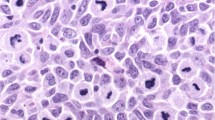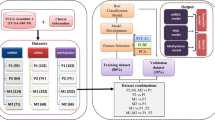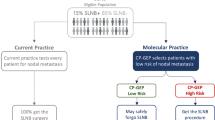Abstract
Melanoma is the leading cause of death from skin cancer in industrialized countries. Clinical and histological variables such as primary tumor invasion, ulceration, and lymph node status might fail to identify early-stage disease that will eventually progress. Tumor biomarkers might help to identify patients with early-stage melanoma who are likely to develop advanced disease and would benefit from additional therapies. These biomarkers offer the possibility of improved tumor staging through the molecular detection of microscopic lymph node metastases that are not visible on routine histological examination. We focus on biomarkers localized to the tumor tissue and those of prognostic value. We give an overview of the melanoma biomarkers that are most helpful for prediction of patients' outcomes, and discuss the primary melanoma biomarkers that have been shown to be of prognostic significance independent of primary tumor thickness and other common clinical prognostic indicators. Although such tumor-associated biomarkers are thought to have the greatest potential, a lack of reliable data makes their true clinical utility difficult to determine. We conclude that several biomarkers show promise in early studies; however, additional large-scale studies are warranted. We suggest cautious optimism for the field of melanoma biomarkers, which we expect to be translated into clinical practice over the next few years.
This is a preview of subscription content, access via your institution
Access options
Subscribe to this journal
Receive 12 print issues and online access
$209.00 per year
only $17.42 per issue
Buy this article
- Purchase on Springer Link
- Instant access to full article PDF
Prices may be subject to local taxes which are calculated during checkout
Similar content being viewed by others
References
Slingluff CL et al. (1988) Lethal “thin” malignant melanoma. Identifying patients at risk. Ann Surg 208: 150–161
Balch CM et al. (2001) Prognostic factors analysis of 17,600 melanoma patients: validation of the American Joint Committee on Cancer melanoma staging system. J Clin Oncol 19: 3622–3634
Bosserhoff AK (2006) Novel biomarkers in malignant melanoma. Clin Chim Acta 367: 28–35
Ilmonen S et al. (2005) Ki-67, Bcl-2, and p53 expression in primary and metastatic melanoma. Melanoma Res 15: 375–381
Carlson JA et al. (2005) Molecular diagnostics in melanoma. J Am Acad Dermatol 52: 743–775
Alonso SR et al. (2004) Progression in cutaneous malignant melanoma is associated with distinct expression profiles. Am J Pathol 164: 193–203
Väisänen A et al. (1998) Prognostic value of MMP-2 immunoreactive protein (72 kD type IV collagenase) in primary skin melanoma. J Pathol 186: 51–58
Dai DL et al. (2005) Prognostic significance of activated Akt expression in melanoma: a clinicopathologic study of 292 cases. J Clin Oncol 23: 1473–1482
Thies A et al. (2002) CEACAM1 expression in cutaneous malignant melanoma predicts the development of metastatic disease. J Clin Oncol 20: 2530–2536
Scala S et al. (2005) Expression of CXCR4 predicts poor prognosis in patients with malignant melanoma. Clin Cancer Res 11: 1835–1841
Giatromanolaki A et al. (2003) Hypoxia-inducible factors 1α and 2α are related to vascular endothelial growth factor expression and a poor prognosis in nodular malignant melanomas of the skin. Melanoma Res 13: 493–501
Straume O et al. (2000) Loss of nuclear p16 protein expression correlates with increased tumor cell proliferation (Ki-67) and poor prognosis in patients with vertical growth phase melanoma. Clin Cancer Res 6: 1845–1853
Straume O and Akslen LA (1997) Alterations and prognostic significance of p16 and p53 protein expression in subgroups of cutaneous melanoma. Int J Cancer 74: 535–539
Hieken TJ et al. (1999) Molecular prognostic markers in intermediate-thickness cutaneous malignant melanoma. Cancer 85: 375–382
Salti GI et al. (2000) Micropthalmia transcription factor: a new prognostic marker in intermediate-thickness cutaneous malignant melanoma. Cancer Res 60: 5012–5016
Vereecken P et al. (2007) Significance of cell kinetic parameters in the prognosis of malignant melanoma: a review. J Cutan Pathol 34: 139–145
Fang D et al. (2001) Expression of microtubule-associated protein 2 in benign and malignant melanocytes: implications for differentiation and progression of cutaneous melanoma. Am J Pathol 158: 2107–2115
Soltani MH et al. (2005) Microtubule-associated protein 2, a marker of neuronal differentiation, induces mitotic defects, inhibits growth of melanoma cells, and predicts metastatic potential of cutaneous melanoma. Am J Pathol 166: 1841–1850
Lehmann JM et al. (1987) Discrimination between benign and malignant cells of melanocytic lineage by two novel antigens, a glycoprotein with a molecular weight of 113,000 and a protein with a molecular weight of 76,000. Cancer Res 47: 841–845
Pacifico et al. (2005) Development of a tissue array for primary melanoma with long-term follow-up: discovering melanoma cell adhesion molecule as an important prognostic marker. Plast Reconstr Surg 115: 367–375
Ostmeier H et al. (2001) Prognostic immunohistochemical markers of primary human melanomas. Br J Dermatol 145: 203–209
Danen EH et al. (1996) E-cadherin expression in human melanoma. Melanoma Res 6: 127–131
Nishizawa et al. (2005) Clinicopathologic significance of dysadherin expression in cutaneous malignant melanoma: immunohistochemical analysis of 115 patients. Cancer 103: 1693–1700
Curtin et al. (2005) Distinct sets of genetic alterations in melanoma. N Engl J Med 353: 2135–2147
Bachmann IM et al. (2005) Importance of P-cadherin, β-catenin, and Wnt5a/Frizzled for progression of melanocytic tumors and prognosis in cutaneous melanoma. Clin Cancer Res 11: 8606–8614
Kageshita T et al. (2001) Loss of β-catenin expression associated with disease progression in malignant melanoma. Br J Dermatol 145: 210–216
Weinlich G et al. (2006) Metallothionein—overexpression as a highly significant prognostic factor in melanoma: a prospective study on 1,270 patients. Br J Cancer 94: 835–841
Winnepenninckx V et al. (2006) Gene expression profiling of primary cutaneous melanoma and clinical outcome. J Natl Cancer Inst 98: 472–482
Rangel J et al. (2006) Prognostic significance of nuclear receptor coactivator-3 overexpression in primary cutaneous melanoma. J Clin Oncol 24: 4565–4569
McKusick-Nathans Institute of Genetic Medicine (1985) Online Mendelian Inheritance in Man [http://www.ncbi.nlm.nih.gov/omim/] (accessed 25 September 2008)
McKusick-Nathans Institute of Genetic Medicine (1985) OMIM Nuclear Receptor Coactivator 3 [http://www.ncbi.nlm.nih.gov/entrez/dispomim.cgi?id=601937] (accessed 25 September 2008)
Barks JH et al. (1997) Increased chromosome 20 copy number detected by fluorescence in situ hybridization (FISH) in malignant melanoma. Genes Chromosomes Cancer 19: 278–285
Thies A et al. (2004) The developmentally regulated neural crest-associated glycotope HNK-1 predicts metastasis in cutaneous malignant melanoma. J Pathol 203: 933–939
Vincent M et al. (1984) A cell surface marker for neural crest and placodal cells: further evolution in peripheral and central nervous system. Dev Biol 103: 468–481
Hao H et al. (2007) E2F-1 induces melanoma cell apoptosis via PUMA up-regulation and Bax translocation. BMC Cancer 7: 24–35
Karst A et al. (2005) PUMA expression is significantly reduced in human cutaneous melanomas. Oncogene 24: 1111–1116
Hammock L et al. (2006) Chromogenic in situ hybridization analysis of melastatin mRNA expression in melanomas from American Joint Committee on Cancer stage I and II patients with recurrent melanoma. J Cutan Pathol 33: 599–607
Duncan LM et al. (2001) Melastatin expression and prognosis in cutaneous malignant melanoma. J Clin Oncol 19: 568–576
Deeds J et al. (2000) Patterns of melastatin mRNA expression in melanocytic tumors. Hum Pathol 31: 1346–1356
Korabiowska M et al. (2002) GADD153 is an independent prognostic factor in melanoma: immunohistochemical and molecular genetic analysis. Histol Histopathol 17: 805–811
Korabiowska M (1997) Differential expression of growth arrest, DNA damage genes and tumour suppressor gene p53 in naevi and malignant melanoma. Anticancer Res 17: 3697–3700
Straume O and Akslen LA (2002) Importance of vascular phenotype by basic fibroblast growth factor, and influence of the angiogenic factors basic fibroblast growth factor/fibroblast growth factor receptor-1 and ephrin-A1/EphA2 on melanoma progression. Am J Pathol 160: 1009–1019
Wang Y and Becker D (1997) Antisense targeting of basic fibroblast growth factor and fibroblast growth factor receptor-1 in human melanomas blocks intratumoral angiogenesis and tumor growth. Nat Med 3: 887–893
Tran TA et al. (1998) Mitotic cyclins and cyclin-dependent kinases in melanocytic lesions. Hum Pathol 20: 1085–1090
Florenes VA et al. (2001) Cyclin A expression in superficial spreading malignant melanomas correlates with clinical outcome. J Pathol 195: 530–536
Ostmeier H et al. (2001) Prognostic immunohistochemical markers of primary human melanomas. Br J Dermatol 145: 203–209
Ohno H (2006) Pathogenetic and clinical implications of non-immunoglobulin; BCL6 translocations in B-cell non-Hodgkin's lymphoma. J Clin Exp Hematop 46: 43–53
Massi D et al. (2006) Tumour lymphangiogenesis is a possible predictor of sentinel lymph node status in cutaneous melanoma: a case–control study. J Clin Pathol 59: 166–173
Dadras SS et al. (2003) Tumor lymphaniogenesis: a novel prognostic indicator for cutaneous melanoma metastasis and survival. Am J Pathol 162: 1951–1960
Dadras SS et al. (2005) Tumor lymphangiogenesis predicts melanoma metastasis to sentinel lymph nodes. Mod Pathol 18: 1232–1242
Straume O et al. (2003) Independent prognostic impact of lymphatic vessel density and presence of low-grade lymphangiogenesis in cutaneous melanoma. Clin Cancer Res 9: 250–256
Mariani G et al. (2002) Radioguided sentinel lymph node biopsy in malignant cutaneous melanoma. J Nuclear Med 43: 811–827
Brady MS et al. (1997) Sentinel lymph node evaluation in melanoma. Arch Dermatol 133: 1014–1020
Takeuchi H et al. (2004) Prognostic significance of molecular upstaging of paraffin-embedded sentinel lymph nodes in melanoma patients. J Clin Oncol 22: 2671–2680
Li W et al. (2000) Clinical relevance of molecular staging for melanoma: comparison of RT-PCR and immunohistochemistry staining in sentinel lymph nodes of patients with melanoma. Ann Surg 231: 795–803
Wang X et al. (1994) Detection of submicroscopic lymph node metastases with polymerase chain reaction in patients with malignant melanoma. Ann Surg 220: 768–774
Blaheta HJ et al. (1999) Detection of melanoma micrometastasis in sentinel nodes by reverse transcription–polymerase chain reaction correlates with tumor thickness and is predictive of micrometastatic disease in the lymph node basin. Am J Surg Pathol 23: 822–828
Blaheta HJ et al. (1998) Lymph node micrometastases of cutaneous melanoma: increased sensitivity of molecular diagnosis in comparison to immunohistochemistry. Int J Cancer 79: 318–323
Blaheta HJ et al. (2000) Examination of regional lymph nodes by sentinel node biopsy and molecular analysis provides new staging facilities in primary cutaneous melanoma. J Invest Dermatol 114: 637–642
Shivers SC et al. (1998) Molecular staging of malignant melanoma: correlation with clinical outcome. JAMA 280: 1410–1415
Bostick PJ et al. (1999) Prognostic significance of occult metastases detected by sentinel lymphadenectomy and reverse transcriptase–polymerase chain reaction in early-stage melanoma patients. J Clin Oncol 17: 3238–3244
Hoashi T et al. (2005) MART-1 is required for the function of the melanosomal matrix protein PMEL17/GP100 and the maturation of melanosomes. J Biol Chem 280: 14006–14016
Kuo CT et al. (2003) Prediction of disease outcome in melanoma patients by molecular analysis of paraffin-embedded sentinel lymph nodes. J Clin Oncol 21: 3566–3572
Starz H et al. (2003) Tyrosinase RT-PCR as a supplement to histology for detecting melanoma and nevus cells in paraffin sections of sentinel lymph nodes. Mod Pathol 16: 920–929
Rad HH et al. (2004) Tyrosinase-related proteins suppress tyrosinase-mediated cell death of melanocytes and melanoma cells. Exp Cell Res 15: 317–328
Amersi F and Morton DL (2007) The role of sentinel lymph node biopsy in the management of melanoma. Adv Surg 41: 241–256
Gradilone A et al. (2003) Survivin, bcl-2, bax, and bcl-X gene expression in sentinel lymph nodes from melanoma patients. J Clin Oncol 21: 306–312
Grossman D et al. (1999) Expression and targeting of the apoptosis inhibitor, survivin, in human melanoma. J Invest Dermatol 113: 1076–1081
Li Q et al. (2004) Skp2 and p27KIP1 expression in melanocytic nevi and melanoma: an inverse relationship. J Cutan Pathol 31: 633–642
Jørgensen K et al. (2006) Activation of c-jun N-terminal kinase is associated with cell proliferation and shorter relapse-free period in superficial spreading malignant melanoma. Mod Pathol 19: 1446–1455
Bachmann IM et al. (2006) EZH2 expression is associated with high proliferation rate and aggressive tumor subgroups in cutaneous melanoma and cancers of the endometrium, prostate, and breast. J Clin Oncol 24: 268–273
Straume O and Akslen LA (2005) Strong expression of ID1 protein is associated with decreased survival, increased expression of ephrin-A1/EPHA2, and reduced thrombospondin-1 in malignant melanoma. Br J Cancer 93: 933–938
Andersen K et al. (2004) Expression of S100A4 combined with reduced E-cadherin expression predicts patient outcome in malignant melanoma. Mod Pathol 17: 990–997
Streit S et al. (2006) FGFR Arg388 allele correlates with tumor thickness and FGFR4 protein expression with survival of melanoma patients. Br J Cancer 94: 1879–1886
Piras F et al. (2005) The predictive value of CD8, CD4, CD68, and human leukocyte antigen-d-related cells in the prognosis of cutaneous malignant melanoma with vertical growth phase. Cancer 104: 1246–1254
Kammula US et al. (2004) Serial follow-up and the prognostic significance of reverse transcriptase–polymerase chain reaction-staged sentinel lymph nodes from melanoma patients. J Clin Oncol 19: 3989–3996
Thies A et al. (2001) PAS-positive loops and networks as a prognostic indicator in cutaneous malignant melanoma. J Pathol 195: 537–542
Ricaniadis N et al. (2001) Long-term prognostic significance of HSP-70, c-myc and HLA-DR expression in patients with malignant melanoma. Eur J Surg Oncol 27: 88–93
Henrique R et al. (2000) Prognostic value of Ki-67 expression in localized cutaneous malignant melanoma. J Am Acad Dermatol 43: 991–1000
McDermott NC et al. (2000) Immunohistochemical expression of nm23 in primary invasive malignant melanoma is predictive of survival outcome. J Pathol 190: 157–162
Florenes VA et al. (2000) Levels of cyclin D1 and D3 in malignant melanoma: deregulated cyclin D3 expression is associated with poor clinical outcome in superficial melanoma. Clin Cancer Res 6: 3614–3620
Karjalainen JM et al. (1999) p21WAF1/CIP1 expression in stage I cutaneous malignant melanoma: its relationship with p53, cell proliferation and survival. Br J Cancer 79: 895–902
Chana JS et al. (1998) The clinical significance of c-myc oncogene expression in melanomas of the scalp. Br J Plast Surg 51: 191–194
Dietrich A et al. (1997) High CD44 surface expression on primary tumours of malignant melanoma correlates with increased metastatic risk and reduced survival. Eur J Cancer 33: 926–930
Strebhardt K et al. (2000) Prognostic value of pololike kinase expression in melanomas. JAMA 283: 479–480
Grover R et al. (1999) Measurement of c-myc oncogene expression provides an accurate prognostic marker for acral lentiginous melanoma. Br J Plas Surg 52: 122–126
Author information
Authors and Affiliations
Corresponding author
Ethics declarations
Competing interests
Rhoda M Alani declared she is a patent holder for the Johns Hopkins University. The other authors declared no competing interests.
Rights and permissions
About this article
Cite this article
Larson, A., Konat, E. & Alani, R. Melanoma biomarkers: current status and vision for the future. Nat Rev Clin Oncol 6, 105–117 (2009). https://doi.org/10.1038/ncponc1296
Received:
Accepted:
Published:
Issue Date:
DOI: https://doi.org/10.1038/ncponc1296
This article is cited by
-
Evaluation of human melanoma and normal formalin paraffin-fixed samples using Raman and LIBS fused data
Lasers in Medical Science (2022)
-
Metabolomic identification of diagnostic serum-based biomarkers for advanced stage melanoma
Metabolomics (2018)
-
Minimal residual disease in melanoma: circulating melanoma cells and predictive role of MCAM/MUC18/MelCAM/CD146
Cell Death Discovery (2017)
-
Sequential molecular analysis of circulating MCAM/MUC18 expression: a promising disease biomarker related to clinical outcome in melanoma
Archives of Dermatological Research (2014)
-
Odontogenic ameloblast-associated protein (ODAM) inhibits growth and migration of human melanoma cells and elicits PTEN elevation and inactivation of PI3K/AKT signaling
BMC Cancer (2013)



